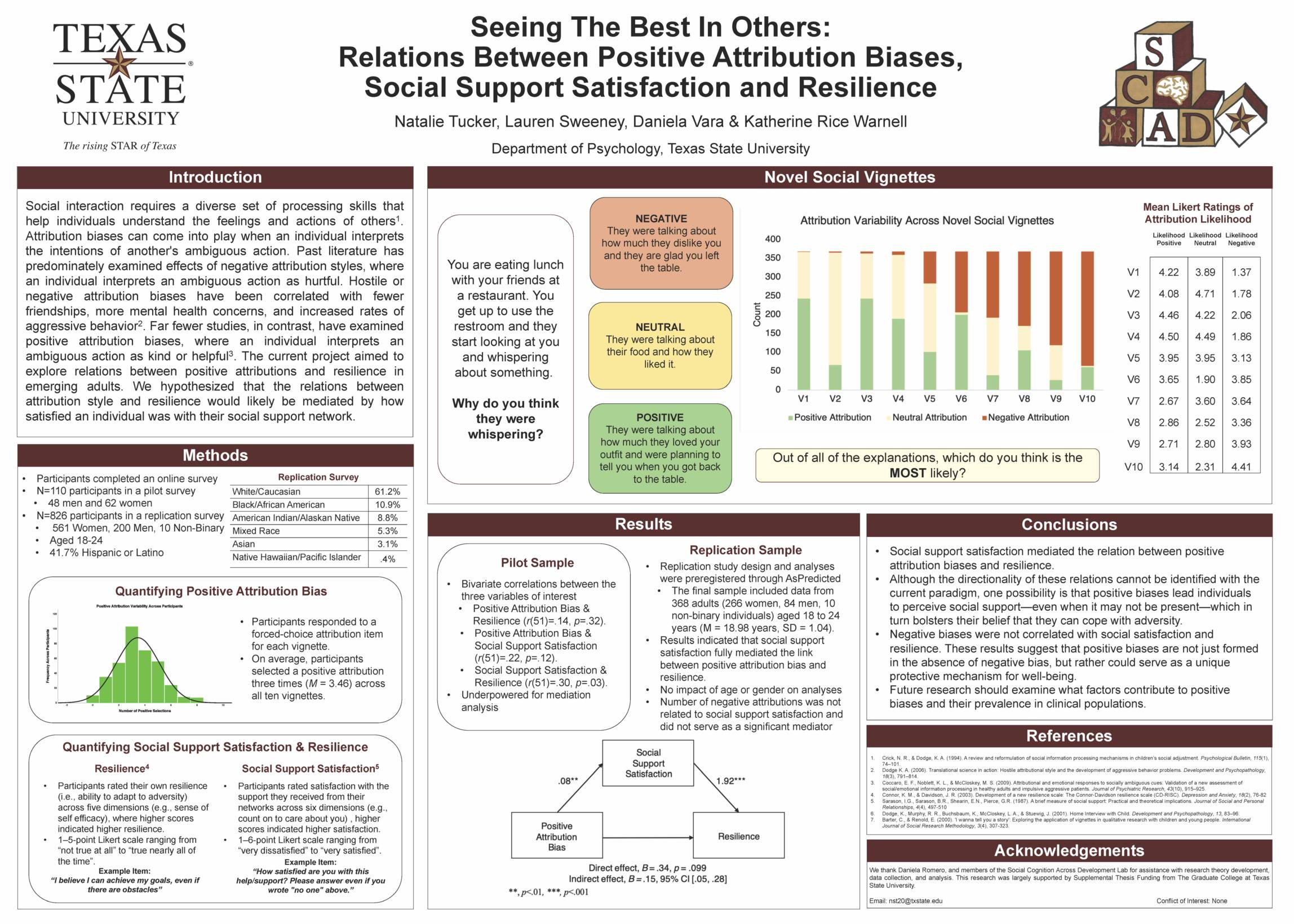-
Acute Stress and the Appeal of High and Low Calorie Food Images
Title: Acute Stress and the Appeal of High and Low Calorie Food Images
Author: Chloe Davis
Co-author(s): Enjulie Vasquez, Natalie Ceballos, & Reiko Graham
Abstract:
Food captures attention, eliciting motivations that can lead to over-consumption. This study examined the role of anxiety, hunger, emotional eating, body mass index (BMI), dieting, and external eating (being triggered to eat by food sights/smells) in ratings of food appeal. Forty females (mean age = 21.1) completed self-report measures followed by an appeal rating task consisting of 20 high-calorie sweet, 20 high-calorie savory, 20 low-calorie sweet, and 20 low-calorie savory images before and after an acute stressor or a control task. Analyses revealed that the stressor was ineffective; therefore, the first set of ratings was examined for the whole group. Most favored foods were low-calorie sweets (52.5%); least favorite were low-calorie savory foods (52.5%). Regressions were conducted on ratings and reaction times to most and least favorite foods, with anxiety, state craving, and emotional, external, and restricted eating as predictors. State craving was associated with higher ratings for most, but not least favored foods. External eaters took longer to rate both foods, while dieters were faster to rate least favored foods. BMI was not associated with ratings or reaction times but was positively associated with state anxiety and external eating. These results suggest that our favorite foods are most appealing when we are hungry but this appeal is unassociated with body weight. Rather, our results add to a contradictory body of literature linking state anxiety to BMI and suggest that susceptibility to the food cues may also play an equally important role in body weight.
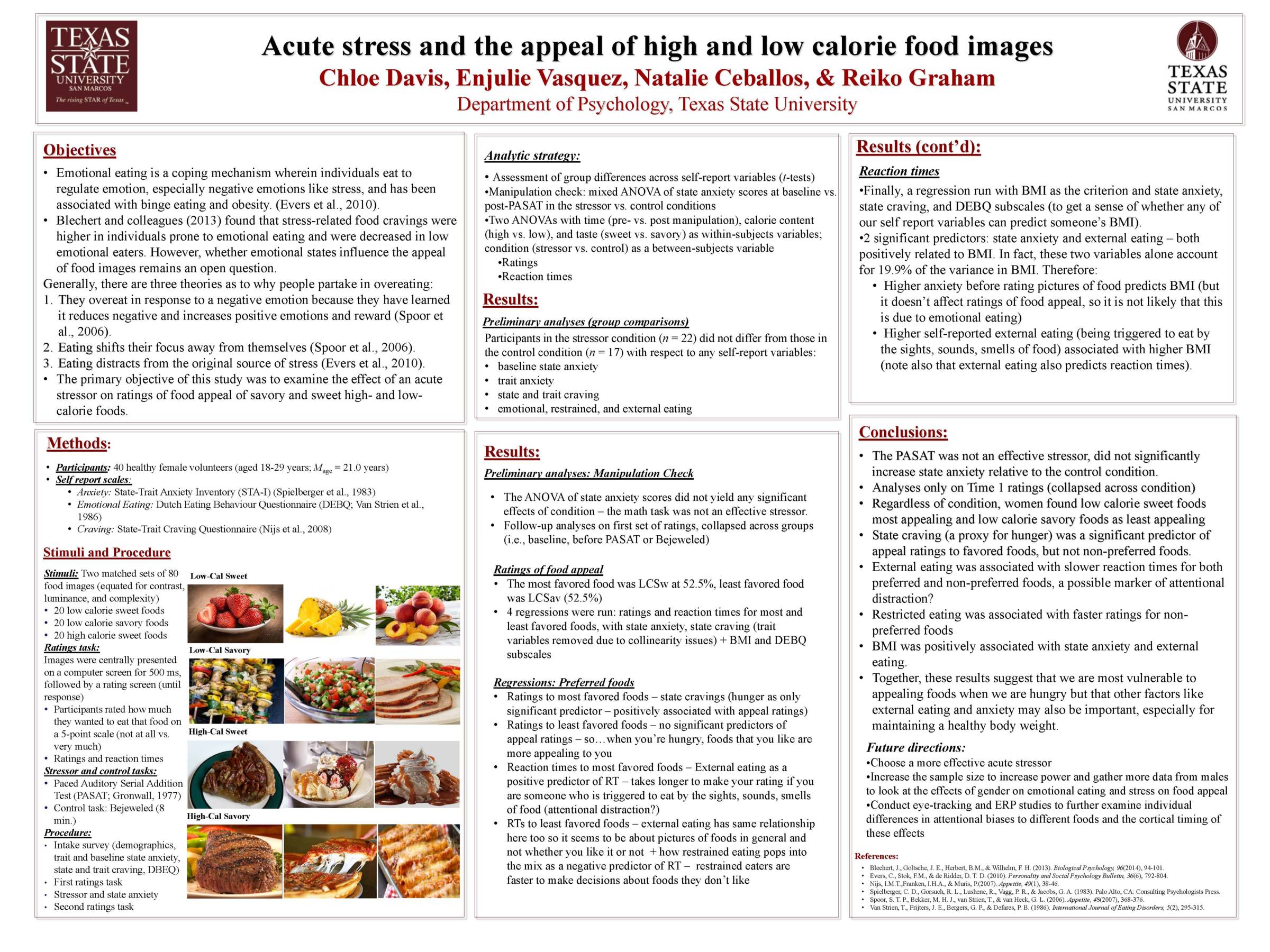
-
Positive Co-Parental Communication and Its Correlation with Parental Stress in Latinx Adolescent Parents
Title: Positive Co-Parental Communication and Its Correlation with Parental Stress in Latinx Adolescent Parents
Author: German Guardiola
Co-author(s): David Reyna & Esteban Guerrero-Ortiz
Abstract:
There has existed a connection in the ways Latinx adolescent parents communicate with their co-parental figures and how everyday experiences have led to different levels of stress outcomes (Perez‐Brena et al., 2020). Parental stress can be defined as a stress that arises when a parent’s perception of the demands of parenting out-strip their resources causing negative circumstances (Coulacoglou & Saklofske, 2017). It is imperative to analyze the impact parental stress has on the Latinx community as they make up one-third of the adolescent population (Martin et al., 2018) and how positive communication can be utilized as a protective factor (Wimsatt et al., 2013). Our study included pregnant and parenting adolescent mothers and fathers (N= 324; 74.7% Female; 100% Latinx, Mage = 16.76, SD= 1.15) who completed an online survey. Results among the participants showed a negative correlation reported between more positive communication with the participants' mother figure and less parental stress. Specifically, mother participants showcased less parental stress when there’s active positive communication involved. However, the relationship between father participants and positive communication were not significantly linked. This suggests that positive communication is a protective factor for stress symptoms relating to being a parent and should be encouraged for adolescent mothers.
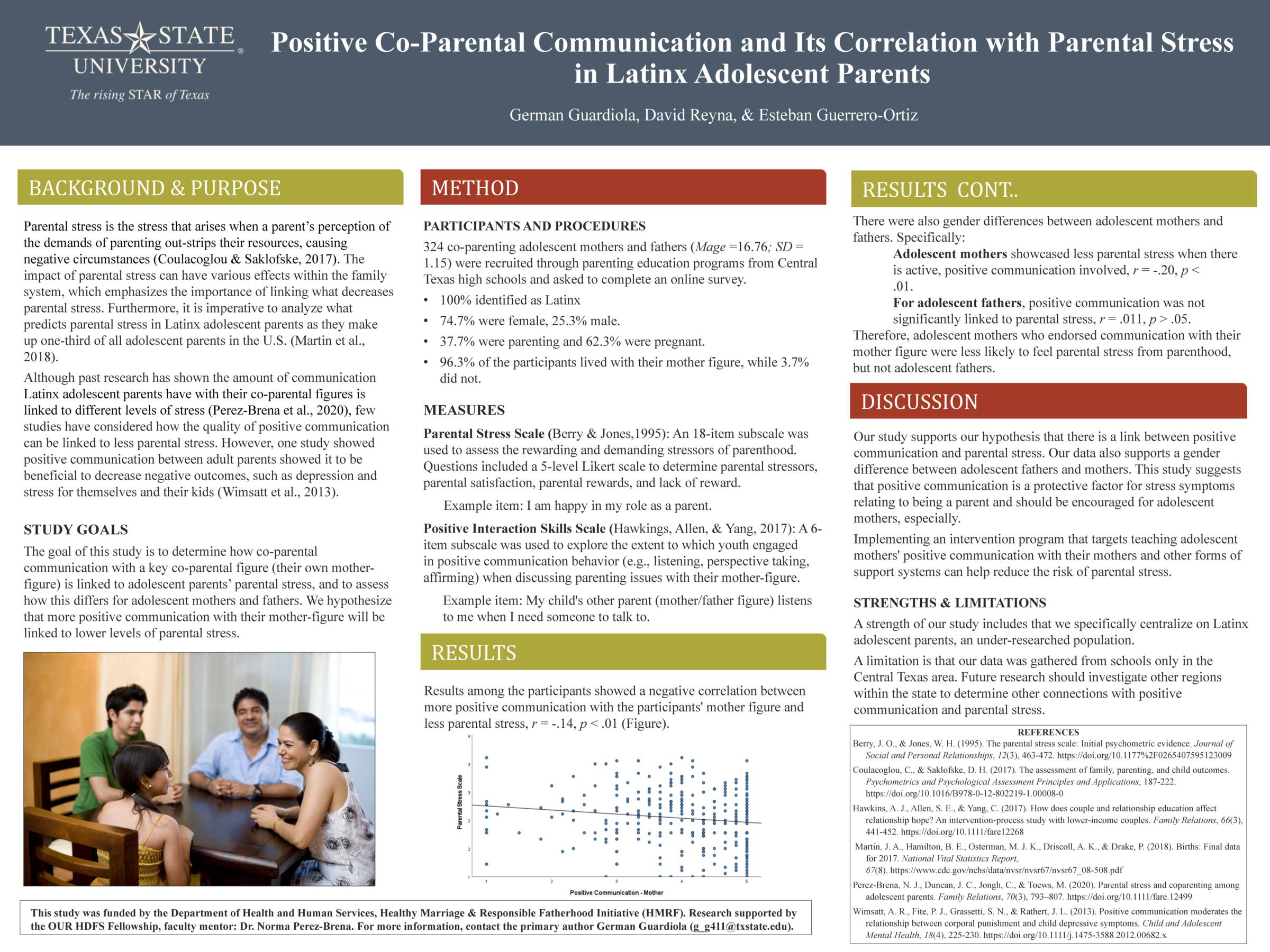
-
Mood Prior to Sleep Influences the Selectivity of Sleep-Dependent Memory Consolidation
Title: Mood Prior to Sleep Influences the Selectivity of Sleep-Dependent Memory Consolidation
Author: Jazmyn Zynda
Co-author(s): Omalys Biggs Rodriguez, Abigayle Nichols, Sladon Gage Smith, & Dr. Carmen Westerberg
Abstract:
Sleep-dependent declarative memory consolidation is selective, in that some recent memories are reactivated and stabilized during sleep more strongly than others. Past research indicates that memory content can influence this selectivity, but the extent to which an individual's mood just prior to sleep can also influence this selectivity is unknown. In the current experiment, participants listened to a short story that included sad, happy, and neutral details. Next, a guided imagery task in which participants imagined experiencing sad scenarios while sad music played was used to induce a sad mood state. Afterward, participants were given a 90-minute break, wherein half of the participants took a nap while electroencephalography was recorded (n = 30) while the other half remained awake (n = 30). Following the break, participants were asked to recall as many details from the story as they could remember. Mood was also assessed prior to story encoding, before the break, and after the break to confirm successful mood induction. Results indicated that the nap group recalled a larger proportion of emotional (both sad and happy) details relative to the wake group, whereas the wake group recalled a larger proportion of neutral details relative to the nap group. Additionally, the proportion of emotional details recalled was positively correlated with non-REM sleep spindle density. These results suggest that pre-sleep mood can influence the selectivity of sleep-dependent memory consolidation. This influence may be mediated by non-REM spindle activity, and has implications for the negative memory bias concomitant with depression.
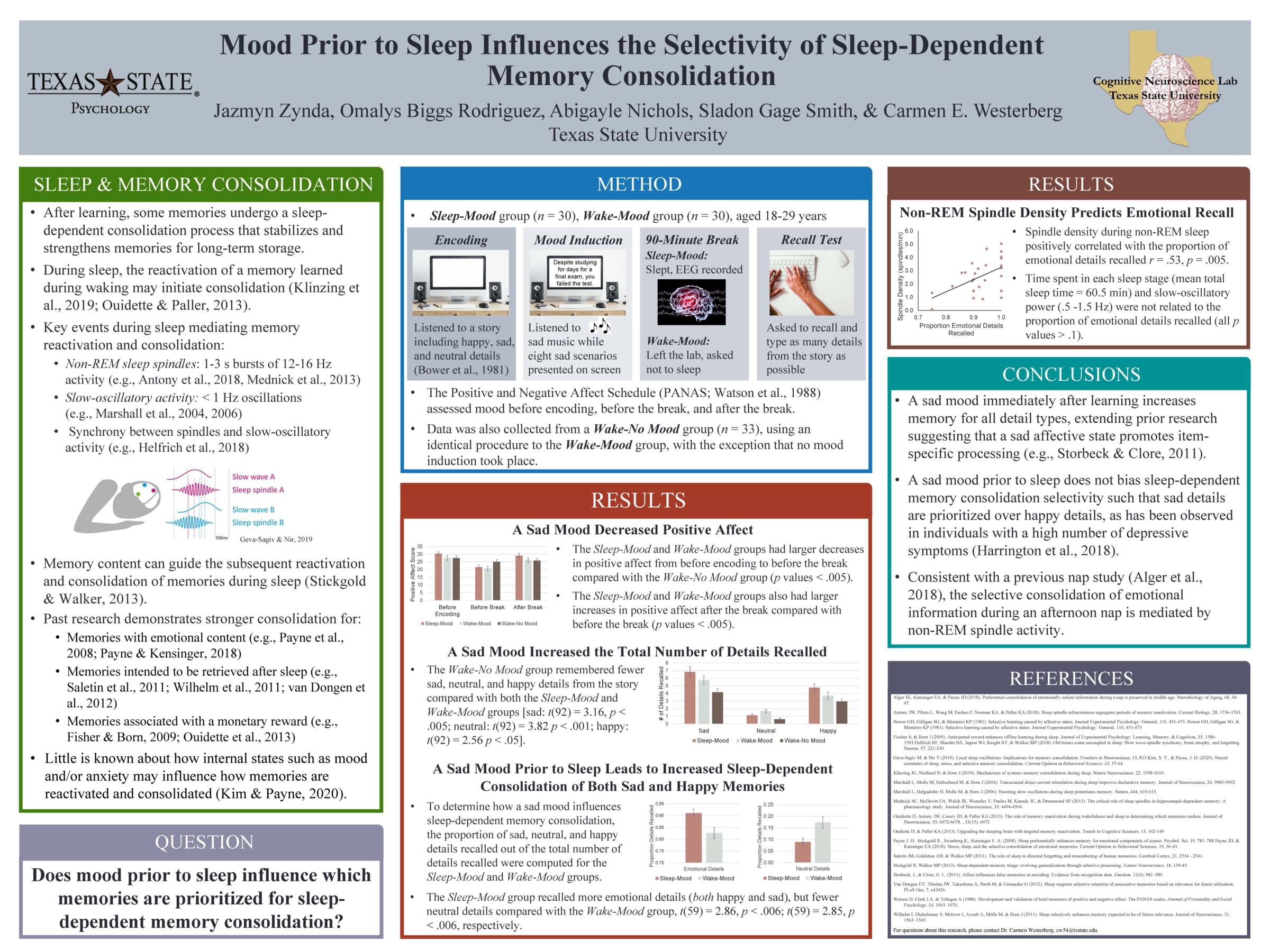
-
Exercise Anxiety: Overcoming the Fear of Working Out to Use as an Effective Prescription for Anxiety-Related Disorders (ARD)
Title: Exercise Anxiety: Overcoming the Fear of Working Out to Use as an Effective Prescription for Anxiety-Related Disorders (ARD)
Author: Jordan Zamarripa
Co-author(s): Pond Ezra & Priscilla Goble
Abstract:
Anxiety and anxiety-related disorders, characterized by immense feelings of fear and distress, affect roughly 40 million adults in the United States each year (Baxter et al., 2010; Mason et al., 2019). Although anxiety disorders are very treatable, only around 37% of individuals seek out treatment (ADAA, 2021). With this overall lack and general delay in receiving treatment, growing evidence suggests exercise may be a helpful and affordable tool in the reduction of anxiety-related symptoms (Dunn and Jewell, 2010). Studies have found that engagement in physical activity overall can prevent feelings of distress, improve psychological well-being, and prevent symptoms of anxiety-related disorders (Dunn and Jewell, 2010). However, general anxiety can transfer to the desire to engage in physical activity (i.e., exercise anxiety), impacting an individual's ability to utilize exercise as an effective means to reducing anxiety. Exercise anxiety is characterized as experiencing both the physical and behavioral symptoms of anxiety when it comes to the thought of or actual engagement in physical exercise (Mason et al., 2019). The idea of exercise anxiety is an emerging topic and a thorough review of literature examining this topic does not exist. Using recent studies examining the relation between anxiety-related disorders and exercise, the proposed review aims to synthesize existing information related to exercise anxiety. The proposed study will also identify areas for future research and suggest ways for exercise to be a more effective regimen for reducing anxiety-related symptoms.
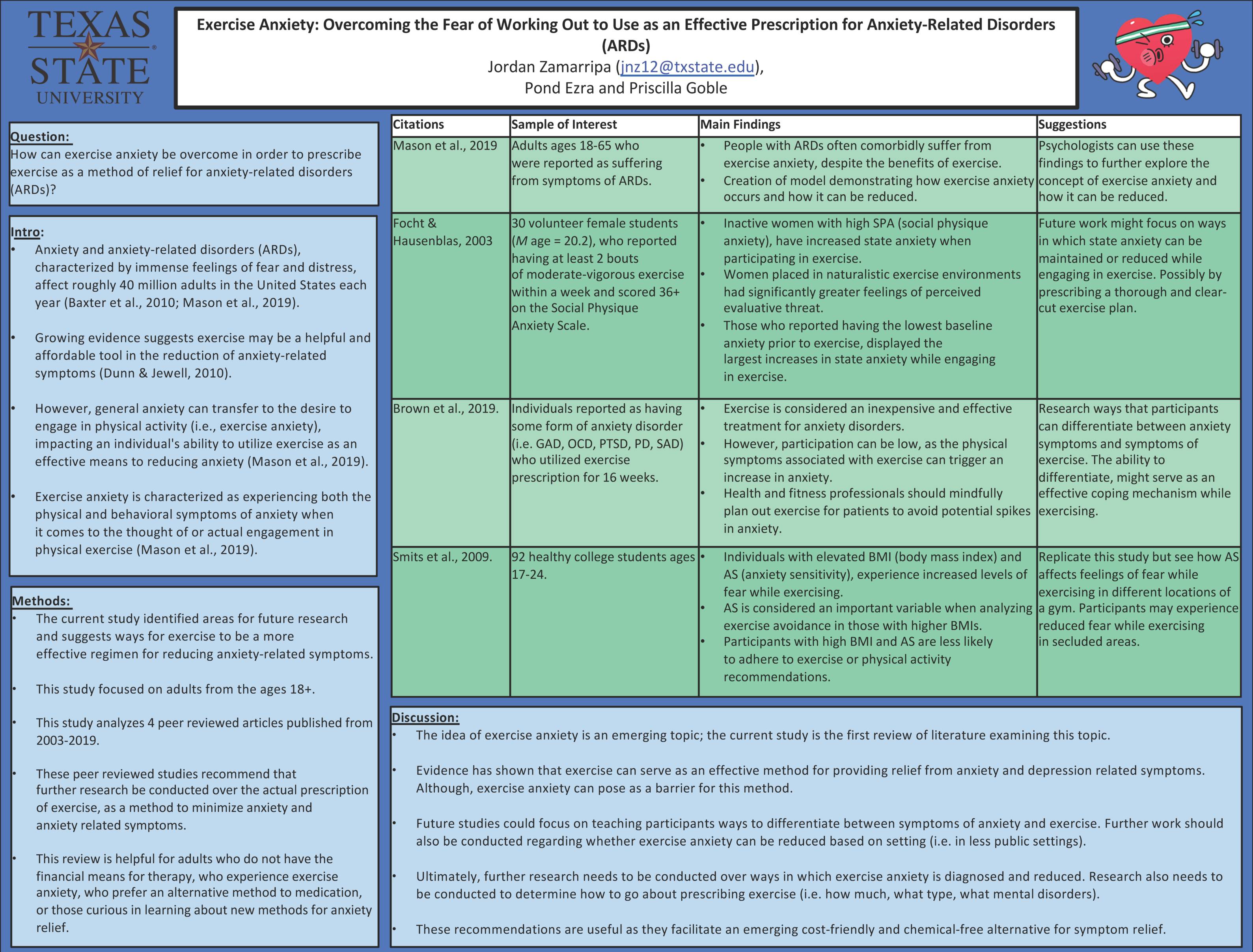
-
Frontal Midline Theta, Cognition, and Reactivity to Images of High Calorie Foods
Title: Frontal Midline Theta, Cognition, and Reactivity to Images of High Calorie Foods
Author: Kaitlin Hall
Co-author(s): Reiko Graham, Frank DePalma, Victoria Leyva, & Natalie Ceballos
Abstract:
Electrical brain activity is quantified in several ways, including trial averaging (yielding a classic event-related waveform representing neural activity to a stimulus) and wavelet analysis (deconstructing the signal into different frequencies). The current study focused on frontal-midline theta (FMT), ~3 to 7 Hz oscillations over frontal areas after the presentation of a stimulus, which is sensitive to cognitive control and may also tap into reward-related activity. We examined this possibility using images of high fat/high calorie foods and a task involving cognitive control. Twenty females (mean age = 21 years) completed a Go/No-go task using pictures of sweet and savory high calorie foods (which should evoke both reward-related activity and cognitive control mechanisms) while EEG was collected. Body mass index, taste preferences, restricted eating, and state and trait craving were also assessed via self-report. Repeated measures ANOVA of FMT yielded a main effect of trial type, with more FMT observed during less frequent no-go trials relative to more frequent go-trials, that was unaffected by taste preferences. Follow-up regressions with FMT as the dependent variable and self-report items as predictors did not reveal any significant relationships between BMI, dieting, or state craving and FMT to the different kinds of food trials. Trait craving was negatively associated with FMT power, but only during sweet go trials. Overall, these results suggest that FMT is sensitive to cognitive control but is not sensitive to differences in individual taste preferences, BMI, or hunger while viewing images of high calorie foods.
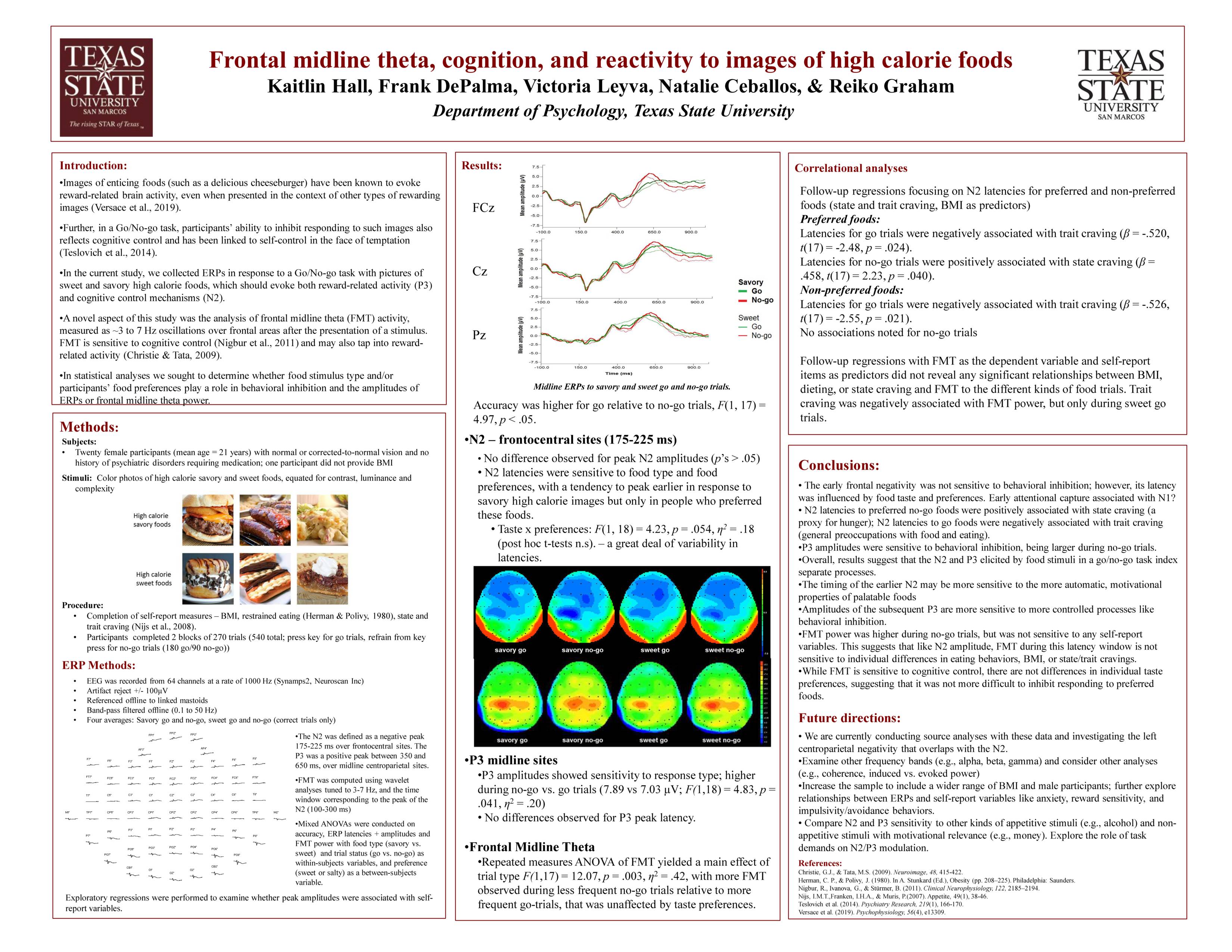
-
College Student Attitudes about Different Course Modalities During COVID-19
Title: College Student Attitudes about Different Course Modalities During COVID-19
Author: Lauren Sweeney
Co-author(s): Dr. Warnell
Abstract:
The COVID-19 pandemic has profoundly impacted student life. In the classroom, students have had increased exposure to online courses, particularly synchronous online formats. Although previous research has compared student experiences in online versus face-to-face classes (e.g., Bhagat et al., 2019; Harrington & Loffredo, 2010), most of that research predates the pandemic and focuses on asynchronous online delivery. Thus, the goal of the current study was to gather a large dataset of student impressions related to COVID with a focus on comparing experiences across course modalities. In Fall 2021, we collected online survey data from N=598 Texas State undergraduate students (74% female, 24% male, 2% non-binary), the majority (75%) of whom were in their first year. Respondents completed several blocks of questions: (1) preferences for different course modalities (e.g., face-to-face, synchronous online); (2) attention to different modalities; (3) perceived impact of COVID on classroom and non-classroom campus experiences; and (4) nervousness about different aspects of returning to campus. The majority of students (53.2%) chose face-to-face as their most preferred format and students rated face-to-face significantly higher (M=4.15 out of 5) than hybrid (M=3.61), asynchronous online (M=3.41), or synchronous online (M=2.94) courses (ps<.001), although some students did rate face-to-face as their least favorite (15.0%). Overall, students also reported attending a significantly higher percentage of face-to-face versus synchronous online lectures (p=.04) and checking their phone significantly less often in face-to-face formats (p<.001). There was great variability in student impressions about the effects of COVID on their college experience. Roughly a third of the sample (38.6%) thought that online classes had a positive impact on their grades and a third (33.3%) thought the opposite, although there were higher levels of agreement for other questions (e.g., 71.6% preferred in-person student organizations). In exploratory analyses, we found higher conscientiousness and higher social support were related to increased preference for face-to-face classes. Overall, findings from this study indicate that students show great variability in their responses to COVID-related changes in the college experience. Ultimately, we hope that this study is a starting point for larger studies examining how preferences relate to learning outcomes, including teacher impressions. This body of work could improve student academic outcomes and well-being.
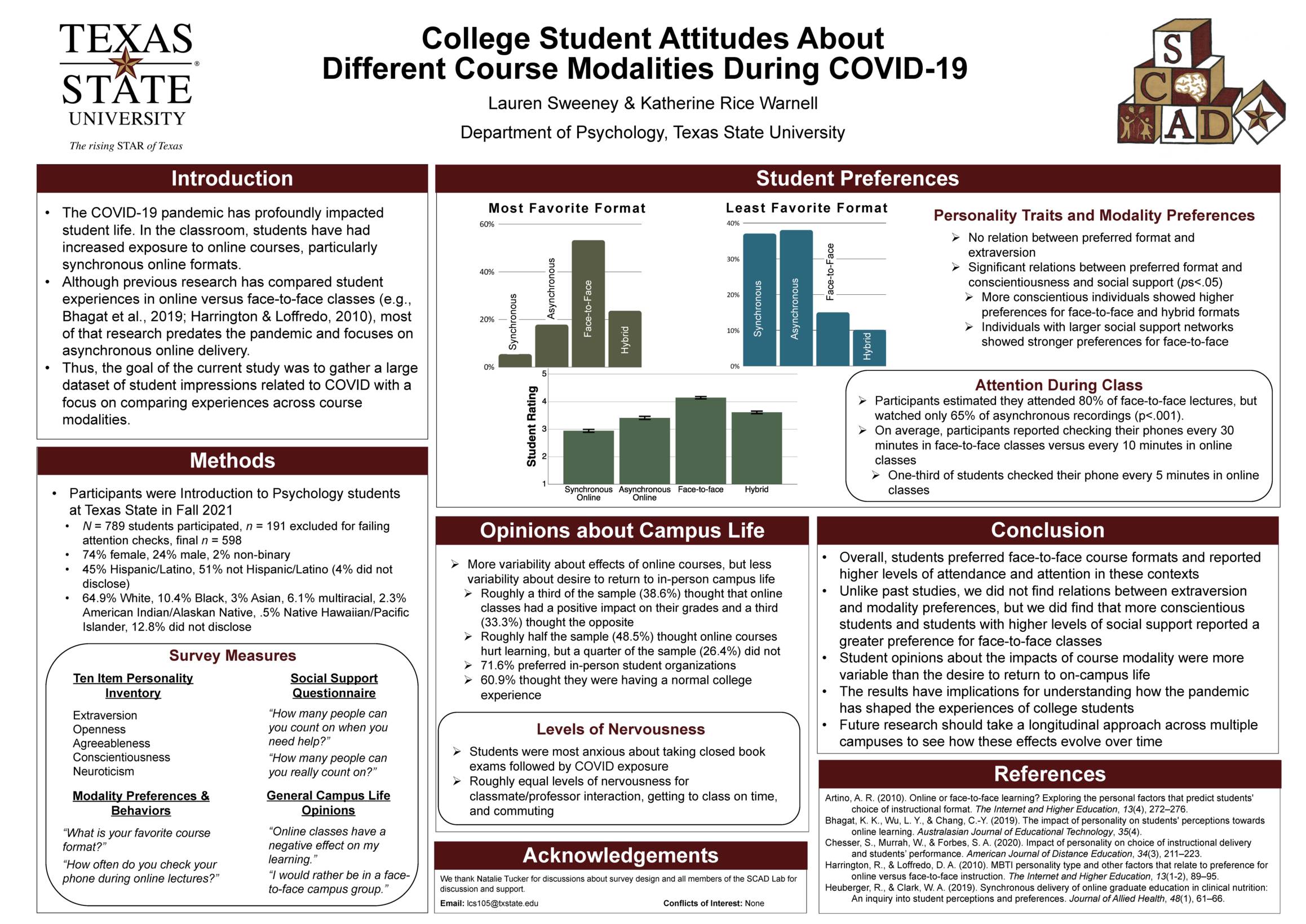
-
Depressive Symptoms, Self-Esteem, and Their Association with Intimate Partner
Title: Depressive Symptoms, Self-Esteem, and Their Association with Intimate Partner
Violence Victimization Among Adolescent Parents
Author: Taylor Russell
Co-author(s): Esteban Guerrero-Oritz
Abstract:
The pervasiveness of interpersonal partner violence (IPV) has been a common issue faced by
adolescents in the U.S that affects the lifelong health, opportunity, and well-being of countless
individuals. Past research suggests that there may be psychological risk (e.g. depression), as well
as protective factors (e.g., self-esteem) when it comes to experiencing this type of abuse. There is
mounting evidence linking depressive symptoms with IPV victimization among U.S. Latinx
women. Latinx women who have experienced childhood trauma, as well as elevated levels of
depression, are more likely to report experiencing IPV. Informed by the existing research, our
goal is to assess how depression and self-esteem relate to Latinx adolescent parents' experiences
of interpersonal relationship violence victimization. Our study included pregnant and parenting
adolescent mothers and fathers (N= 400; 100% Female; 100% Latinx, M age = 16.67, SD= 1.15)
who completed an online survey. Correlational analyses were used. Correlational results showed
a negative association between self-esteem and IPV, such that adolescent girls who reported
higher self-esteem also reported lower levels of IPV victimization. High levels of depression had
a positive association with IPV, such that adolescent girls who reported higher levels of
depression experienced higher levels of IPV victimization.
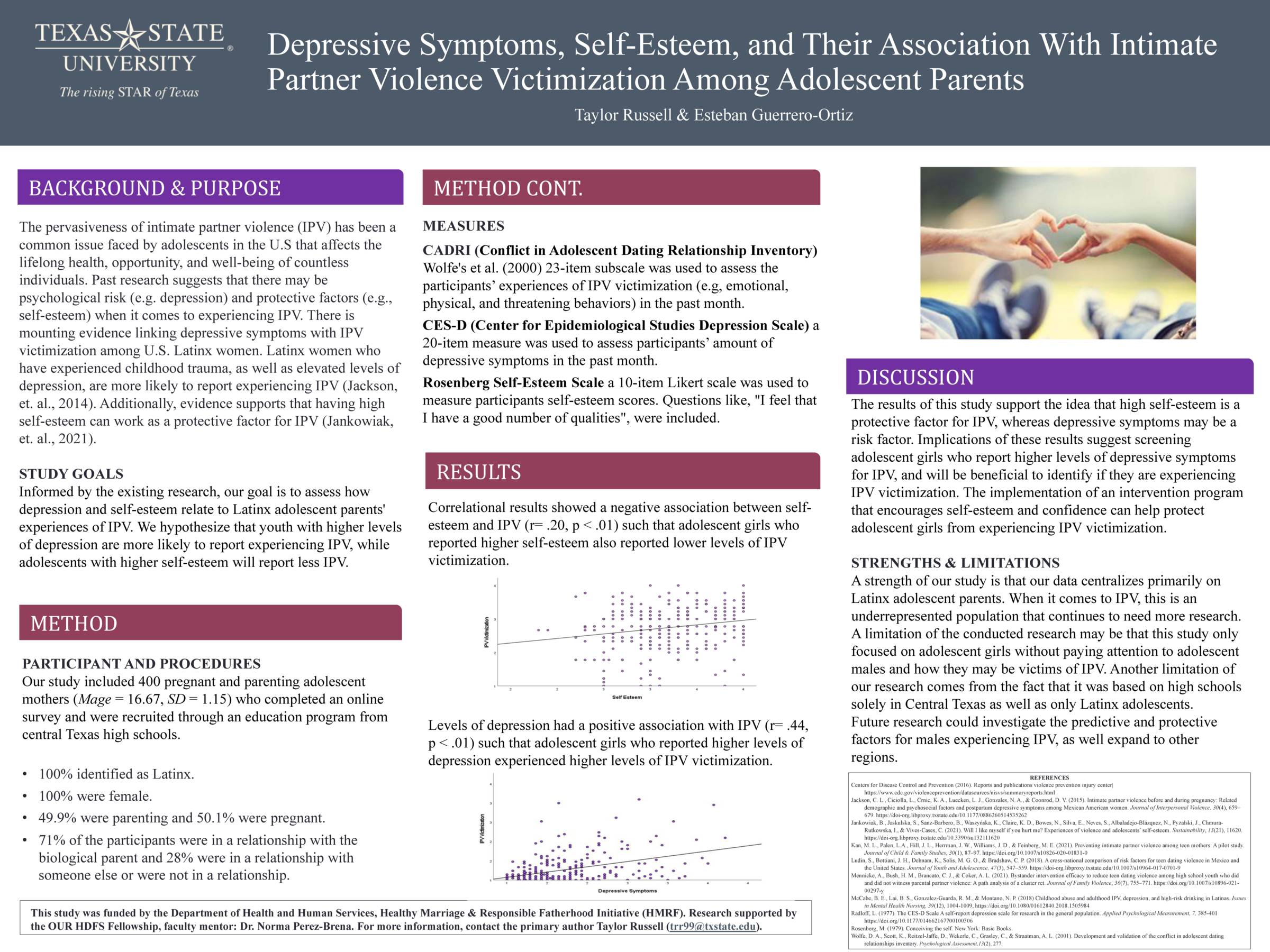
-
Gender Differences in Parenting Restrictions of Latinx Adolescents
Title: Gender Differences in Parenting Restrictions of Latinx Adolescents
Author: Citlally Macias Maya
Co-author(s): Kim Manuel & Esteban Guerrero-Ortiz
Abstract:
Gender socialization is the experiences that inform what are culturally and socially approved forms of behavior for males and females (Philpot, 1997). Gender role attitudes can inform how males and females are treated and seen. Our research is centered around examining the differences in gender-based parenting restrictions within Latinx families and how this affects boys compared to girls. We hypothesized both mothers and fathers would parent differently based on gender, and that girls would have far more restrictive conditions than boys. Other research and common assumptions regarding Latinx gender-socialization commonly argues girls are restricted at a much higher rate than their male relatives. Qualitative responses were coded by a team of researchers to identify reoccurring themes such as protections/restrictions, granting autonomy, and concerns regarding raising adolescents. Our research shows far less distinctive results and based on our data, boys and girls are commonly socialized similarly. We found that most Latinx parents have no differential restrictions between their daughters and sons. However, when the differentiation was present and restrictions were enforced, girls were far more restricted compared to boys. Our research helps dispel common myths regarding Latinx communities that can be harmful in social conversations. Additionally, it provides an uplift of Latinx voices and experiences in spaces where Latinx culture is often under-researched.

-
The Dark Triad Moderates the Association Between Orthorexia Nervosa and Relationship (Dis)Satisfaction
Title: The Dark Triad Moderates the Association Between Orthorexia Nervosa and Relationship (Dis)Satisfaction
Author: Kaitlin Brunett
Co-Author(s): Crystal Oberle
Abstract:
Purpose: Past research has revealed a link between orthorexia nervosa (ON) and relationship dissatisfaction, which has in turn been found to be correlated with the Dark Triad traits. The current study investigated the association ON has with seeking out relationships and with relationship satisfaction, while also assessing a potential moderating effect of the Dark Triad. Method: Recruited from Reddit forums, 788 adults (74% female, 67% White, 63% aged 25-30 years) completed an online survey with the Orthorexia Nervosa Inventory (ONI), Short Dark Triad (SD3), and Relationship Assessment Scale (RAS). Results: Greater ON symptomatology was associated with greater levels of all aspects of the Dark Triad (Machiavellianism, narcissism, and psychopathy), as well as with lower levels of relationship satisfaction (among those in committed romantic relationships) and a lower likelihood of seeking new romantic relationships (among single participants). A regression analysis revealed that the Dark Triad moderated the association between ON and relationship satisfaction, whereby this association was not significant at high levels of the Dark Triad. Conclusion: The current research highlights that at low and medium levels of the Dark Triad, greater ON symptomology is associated with lower levels of satisfaction in romantic relationships.
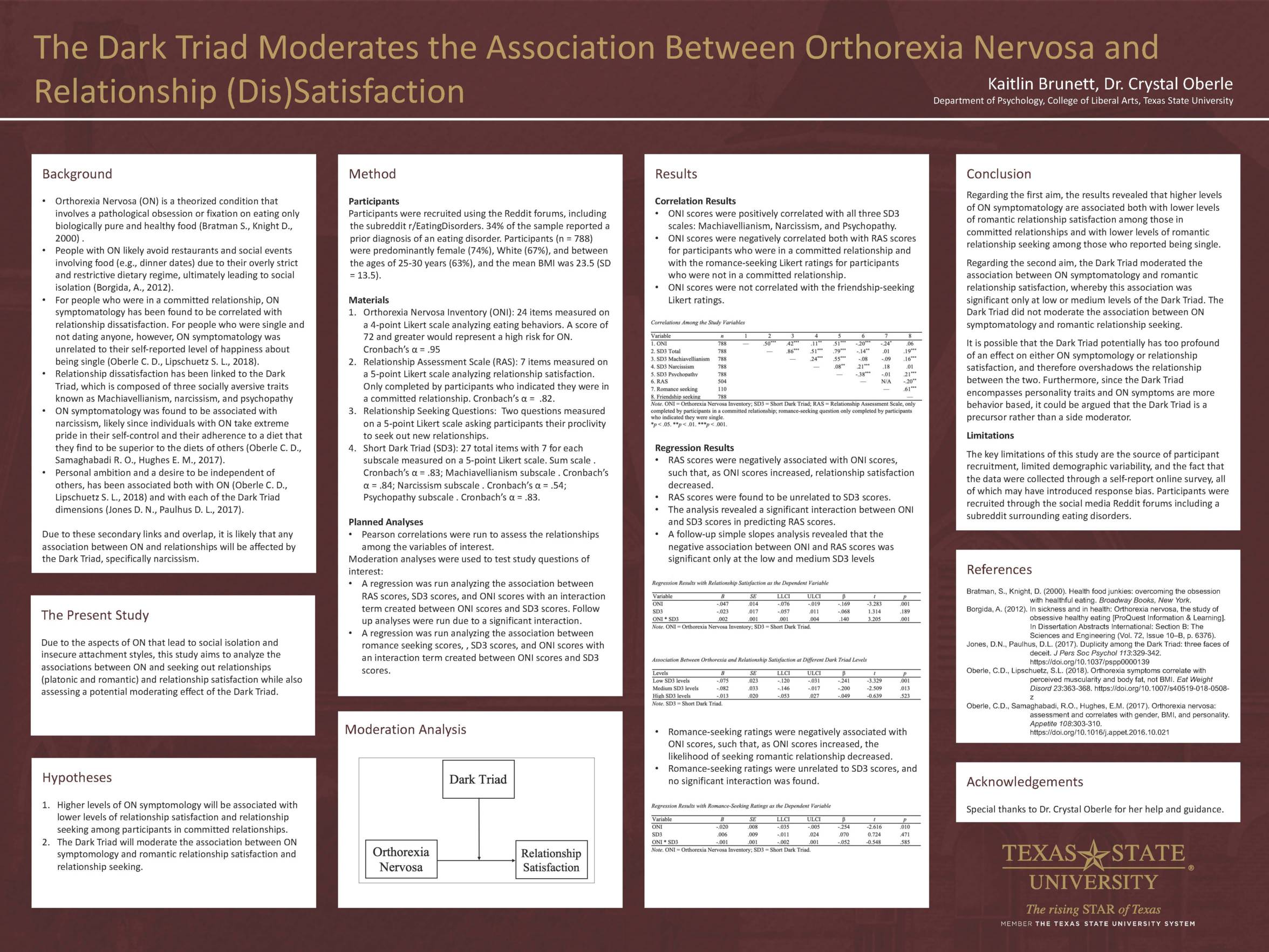
-
Sleep-Dependent Memory Consolidation May Contribute to the Negative Memory Bias in Individuals with a High Number of Depressive symptoms
Title: Sleep-Dependent Memory Consolidation May Contribute to the Negative Memory Bias in Individuals with a High Number of Depressive symptoms
Author: Cheryl Fox
Co-Author(s): Kathryn Wactor, Michael A. Price, & Carmen E. Westerberg
Abstract:
Depression is accompanied by a negative memory bias, such that depressed individuals typically remember more sad details than happy or neutral details compared with non-depressed individuals. This experiment examines whether sad information may be prioritized for sleep-dependent memory consolidation to a greater extent in depressed individuals, which may contribute to their superior memory for sad details. Potential participants took a depression inventory, and those with high or low numbers of depressive symptoms were invited to participate. All qualifying participants listened to a story containing sad, happy, and neutral details. Next, during a 90-minute break, half of each group (high or low depressive symptoms) took a nap and the other halves remained awake. Finally, all participants recalled as many story details as they could remember. All participants who slept recalled a higher proportion of emotional details and a lower proportion of neutral details compared with participants who remained awake. Additionally, for participants who remained awake, there were no differences in the proportion of sad, happy, or neutral details recalled between the high (n=18) and low (n=14) groups. However, for those who slept, a trend to recall a higher proportion of sad details and a lower proportion of happy details was present for participants in the high (n=4) compared with the low (n=10) group. These results indicate that sleep-dependent memory consolidation favors emotional over neutral details, and tentatively suggest that this process is altered in individuals with high depressive symptoms and may contribute to the negative memory bias frequently observed in depression.
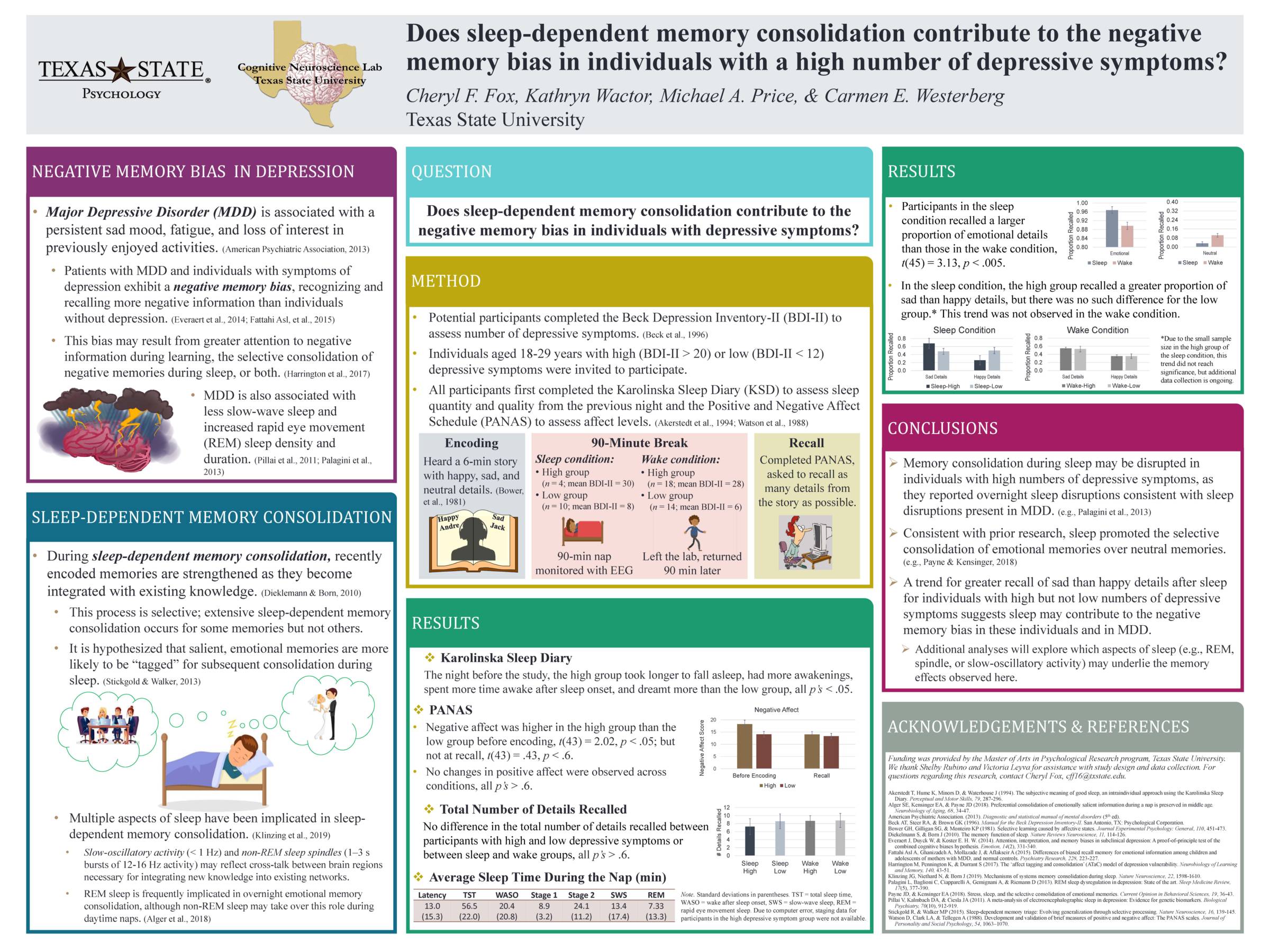
-
Adapting the Inclusion of Others in Self Scale: Assessing How Identity Centrality and Identity Complexity Relate to Alcohol Use among LGBTQiA+ Community Members
Title: Adapting the Inclusion of Others in Self Scale: Assessing How Identity Centrality and Identity Complexity Relate to Alcohol Use among LGBTQiA+ Community Members
Author: Donald Christopher Garcia MacPhail
Co-Author(s): Dr. Jessica K. Perrotte
Abstract:
The LGBTQiA+ community has been the subject of substantial research in regards to substance use behaviors. With this area of research, only a handful of studies have aimed to evaluate the role sexual identity centrality has with substance use. Qualitative research suggests that alcohol use may be a method of sexual identity expression for members of the LGBTQiA+ community. However, quantitative studies examining the link between alcohol use and intersecting identities (e.g., sexual identity, drinking identity) among LGBTQiA+ community members are scarce. Therefore, the aims of the current project were to: 1) Use a modified version of the Inclusion of Others in Self (IOS) Scale to explore how the complexity (i.e., overlap) between LGBTQiA+ identity and drinking identity relate to alcohol use; 2) Examine how identity centrality for both LGBTQiA+ identity and drinking identity relate to alcohol use. With the modified IOS items, understanding into how identity centrality and identity complexity predicts alcohol use severity, specifically. Preliminary bivariate analyses correlated the modified IOS items to previously validated identity centrality questionnaires, as well as with AUDIT scores. Additionally, a multiple regression analysis was used to understand how respective identity centralities and overlap between identities predicted alcohol use behaviors in a multivariate framework. These analyses demonstrate the potential benefits of exploring new avenues of identity measurement and why identity complexity must be explored in future research.

-
Environmental Pollution Dilemma: Cooperation and Competition are Affected by Personal Values, but not by Thoughts of Death
Title: Environmental Pollution Dilemma: Cooperation and Competition are Affected by Personal Values, but not by Thoughts of Death
Author: Derek Mangino-Sirvent
Abstract:
To avoid the catastrophic environmental consequences predicted by many environmental scientists, it is becoming increasingly urgent to address human behaviors that affect planet Earth. Among factors that likely contribute to delayed climate change mitigation are psychological factors, including the lack of cooperation for the cause and the competition for diminishing resources. Personal social values of self-transcendence (pro-social) and self-enhancement (pro-self) seem to be related to attitudes and behaviors of cooperation and competition. Meanwhile, when thinking of frightening chaotic scenarios, self-enhancing competitive values and attitudes increase, and upon contemplating one’s own mortality pro-social cooperative values and attitudes increase. In the current experiment, after measuring participants’ self-enhancement and self-transcendence values, using Stern’s Brief Inventory of Values (BIV), participants wrote about dental pain (DP), their own death (MS), or extinction of life on Earth (ELE), to prime them into one of these negative scenarios. Following a series of distracting tasks, participants’ levels of cooperation and competition were measured using the Cooperation and Competition Personality Scale (CCPS) and a commons dilemma task (CD). Some hypotheses were not supported (the manipulation had no significant effects on the dependent measures), yet there are significant positive correlations between self-transcendence and cooperation and between self-enhancement and competition.
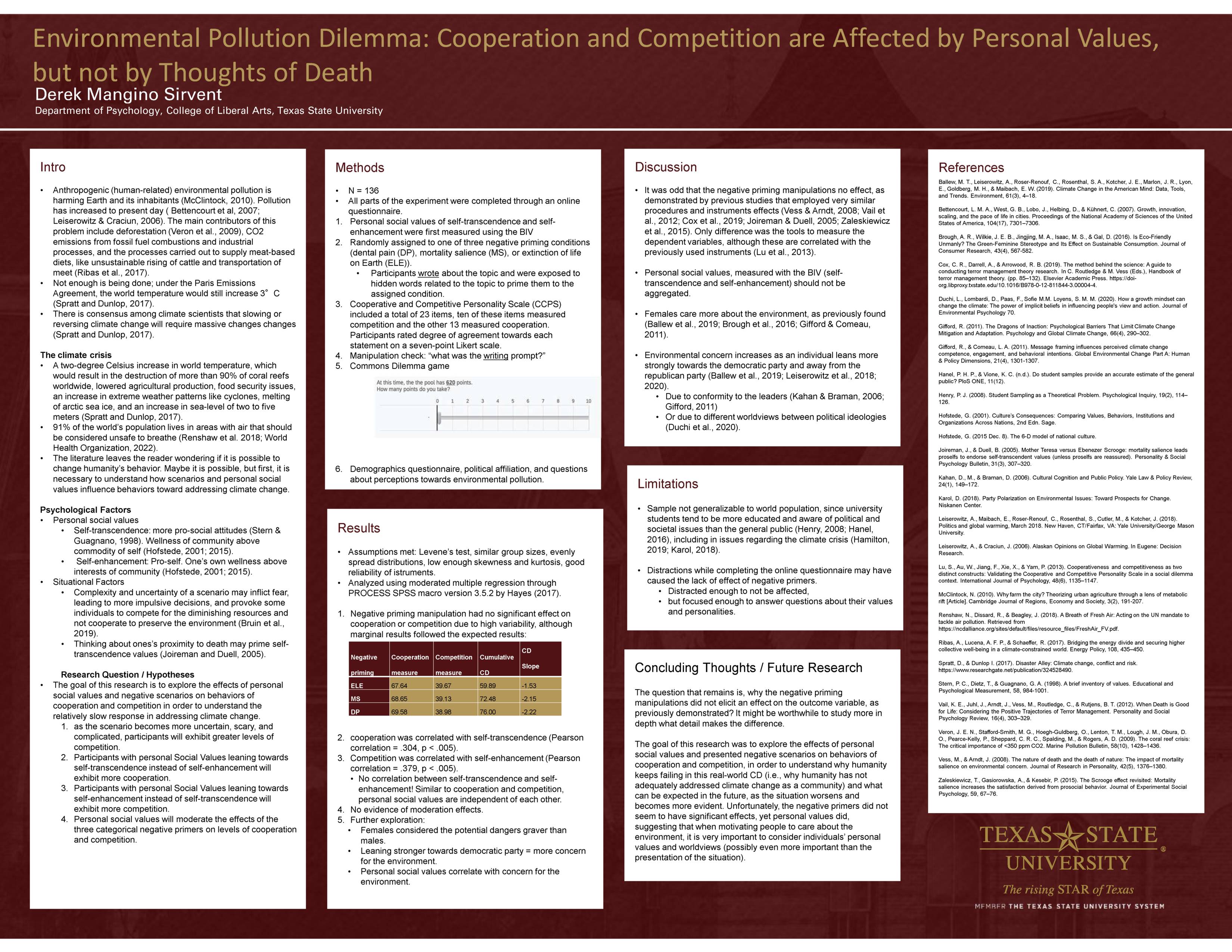
-
Exploring Cognitive Language of CEOs during the COVID-19 Pandemic Over Time and its Connection to Decision Processing
Title: Exploring Cognitive Language of CEOs during the COVID-19 Pandemic Over Time and its Connection to Decision Processing
Author: Steven Mesquiti
Abstract:
This study leverages text analysis methods to vet the psychological interaction between CEOs and their investors. In particular, this project considers the cognitive language CEOs use during critical announcements where they explain the success or failure of their company: quarterly earnings calls. To do this, our study analyzed a large quantity (N = 96, 844) of transcribed quarterly earnings calls from over 1,400 publicly-traded companies through LIWC to observe how CEOs’ linguistic patterns change before, during, and after the pandemic. Results indicate unique linguistic patterns in cognitive processing and analytical thinking exist that may elucidate the decision-making processes of CEOs during cultural upheaval events. For instance, executives were found to use analytic words, or words related to concrete ideas, at lower rates at the onset of the pandemic than the months leading up to and following Lockdown. One explanation for this could be that CEOs—and consequently their companies—were unsure with how to formalize a response plan and therefore struggled to use structured, formal thought. Therefore, this study’s exploration of these phenomena, over insight into the psychology of a CEO, over the course of the Pandemic.

-
Autistic Traits Modulate the Relation between Perceived and Actual Social Cognitive Ability
Title: Autistic Traits Modulate the Relation between Perceived and Actual Social Cognitive Ability
Author: Daniela Romero
Co-Author(s): Natalie Tucker, Lauren Sweeney, & Katherine R. Warnell
Abstract:
In spite of growing literature on the nuances of mentalizing, or theory of mind, in autism (e.g., Livingston et al., 2019), little research has examined the relation between one’s actual mentalizing ability and one’s perception of that ability. One possibility is that those with higher autistic traits are hyperaware of their social abilities, potentially even underestimating their true performance. Alternatively, higher autistic traits may be linked to a decreased awareness of one’s skills or even systematic overestimation. These effects may also vary with mentalizing ability. Understanding relations between perceived and actual ability has implications for understanding compensatory and camouflaging behaviors.
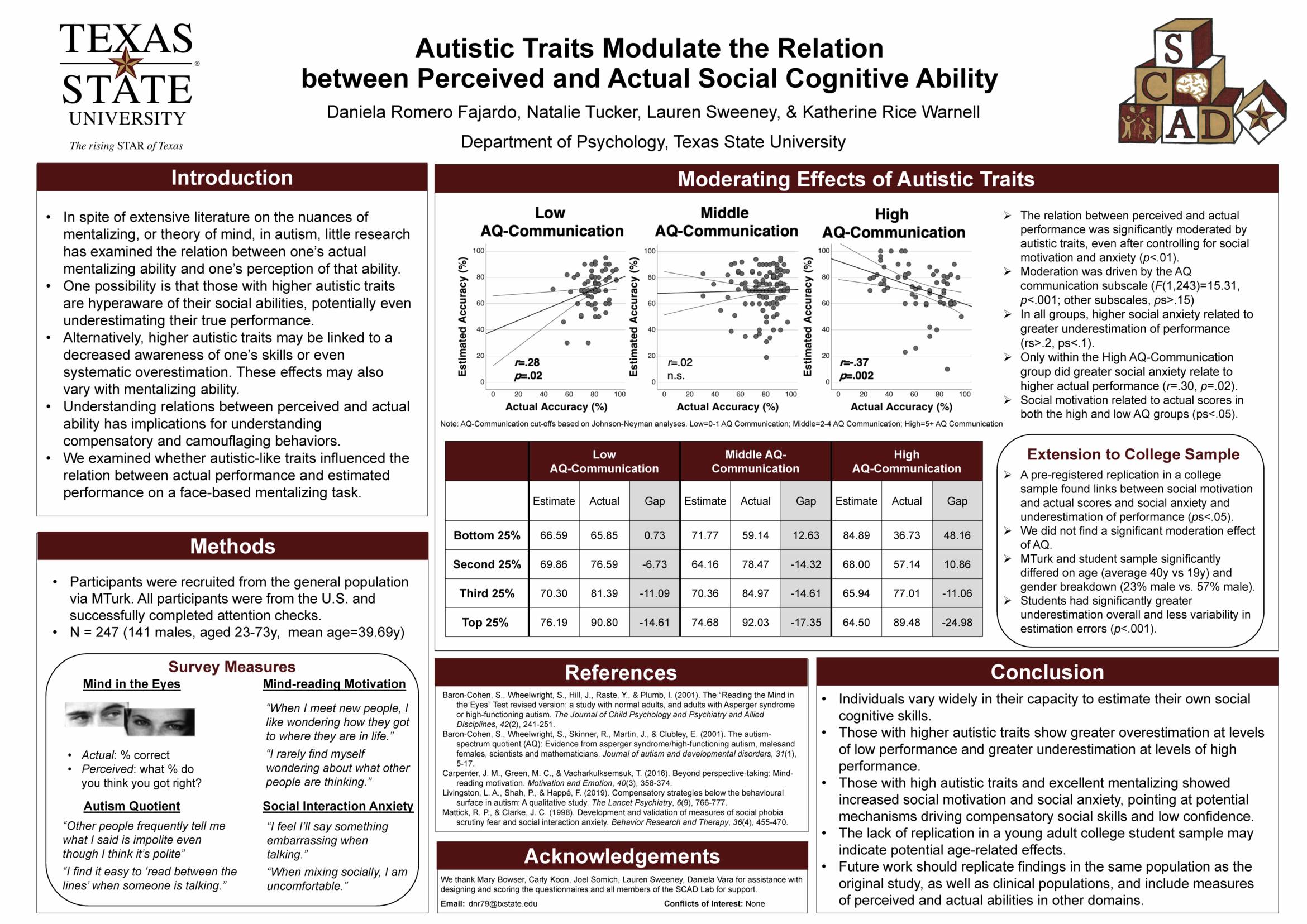
-
Comparing the Occurrences of Impossible Content in Chinese and U.S. Picture Books
Title: Comparing the Occurrences of Impossible Content in Chinese and U.S. Picture Books
Author: Adine A. DeLeon
Co-Author(s): Jenny Nissel, Yao Lu, Jacqueline D. Woolley, & Jennifer M. Clegg
Abstract:
Research suggests that Chinese and U.S. adults evaluate the possibility of fantastical events in similar ways (Gong & Shtulman, 2021). One explanation for this similarity is that fantastical events are presented in comparable ways in Chinese and U.S. media, though work in literary theory suggests otherwise (Gu, 2006). To investigate this, we coded the occurrence of impossible (i.e., violating causal laws) characters, setting, and objects in bestselling and award-winning picture books from China and the U.S. from 2012 - 2019, (n = 87 Chinese books, n = 81 U.S. books). We found no difference between China and the U.S. in the frequency of impossible characters (t(166) = -0.89, p = 0.377), settings (χ2= 1.28, p = 0.526), and objects (χ2= 1.50, p = 0.221). We are also interested in whether impossible characters tended to be explicitly fantastical (i.e., magical). Further investigation revealed that if characters were impossible, they were equally likely to be fantastical in Chinese and U.S. books (OR = 1.92, p = .694). Implications of these findings for children’s reasoning about fantasy, possibility, and reality will be discussed.
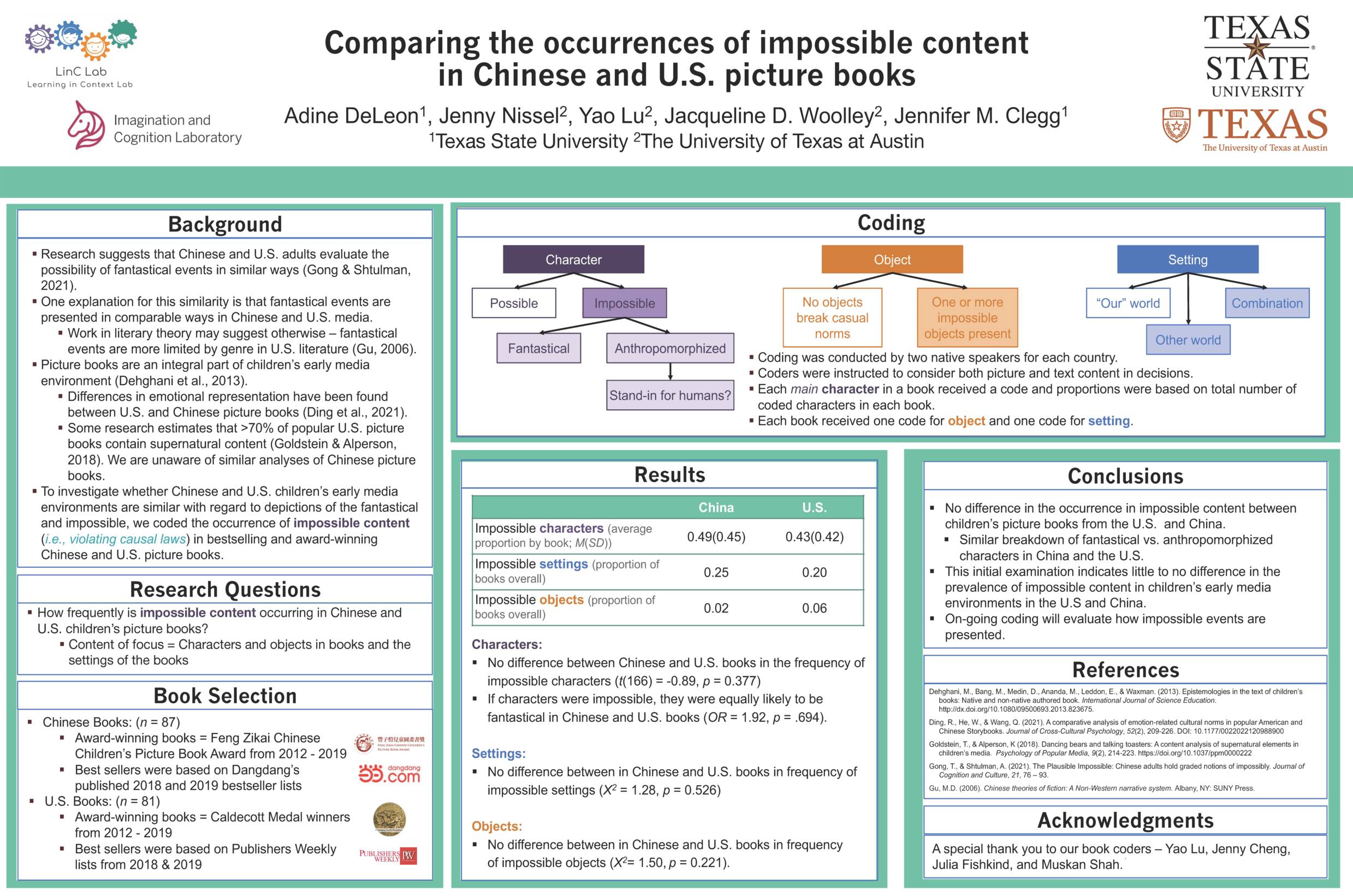
-
Changes in Dream Intensity and Nightmare Frequency during the COVID-19 Pandemic are Influenced by Personality
Title: Changes in Dream Intensity and Nightmare Frequency during the COVID-19 Pandemic are Influenced by Personality
Author: Michael A. Price
Co-Author(s): Julie Niziurski, Krista Howard, & Carmen Westerberg
Abstract:
Several reports of increased dreaming emerged during the COVID-19 pandemic. However, few studies have investigated the aspects of dreaming behaviors that were most impacted and it is unknown if certain demographic groups or people with certain personality characteristics are more susceptible to these changes. To investigate this further, 596 participants from the U.S. and Germany completed a survey during April 2021, which included measures of the Big 5 personality factors and measures of dream recall frequency and intensity, attitude towards dreams, the effects of dreams on waking life, and other aspects of dreaming behaviors, both before and during the pandemic. Dream intensity and nightmare frequency increased during the pandemic compared with before the pandemic in all participants, and these increases were greatest for females and individuals with some university experience compared with other gender groups and other education levels. Additionally, neuroticism and conscientiousness were negatively associated with dream intensity during the pandemic, which may reflect less pandemic-related stress in neurotic and conscientious individuals, given their pre-existing tendencies to be organized and to adhere to rules. On the other hand, agreeableness was positively associated with dream intensity and nightmare frequency during the pandemic, which could reflect conflict between the prosocial nature of highly agreeable individuals and the isolation necessitated by the pandemic. Collectively, these results suggest that increased dream intensity and nightmares in agreeable individuals may increase their risk for mental health issues, whereas neuroticism and conscientiousness may protect individuals from the negative consequences associated with intense dreaming during the pandemic.

-
Seeing the Best in Others: Relations Between Positive Attribution Biases, Social Support Satisfaction and Resilience
Title: Seeing the Best in Others: Relations Between Positive Attribution Biases, Social Support Satisfaction and Resilience
Author: Natalie. S. Tucker
Co-Author(s): Lauren Sweeney, Daniela Vara, & Katherine R. Warnell
Abstract:
Humans differ in how they attribute intention to others’ ambiguous acts (e.g., someone hitting you with a ball in the park). Much research examining attribution biases has asked participants to choose between a negative explanation (e.g., the ball thrower was trying to make you angry) and a neutral one (e.g., the thrower made a mistake). Such research has robustly linked negative, or hostile, attribution biases to poorer psychosocial outcomes. Little work, however, has examined whether well-being is bolstered by positive biases (e.g., the thrower was hoping you would join their game). In the current study, we used customized social vignettes and asked participants to rate the likelihood of positive, neutral, and negative explanations. In a pilot sample of 110 adults, we found that positive attribution biases were linked to increased perceptions of social support and higher resilience. We conducted a pre-registered replication of this finding and found that social support mediates the link between positive biases and resilience, potentially because individuals with such biases perceive themselves to be supported even in the face of adversity.
